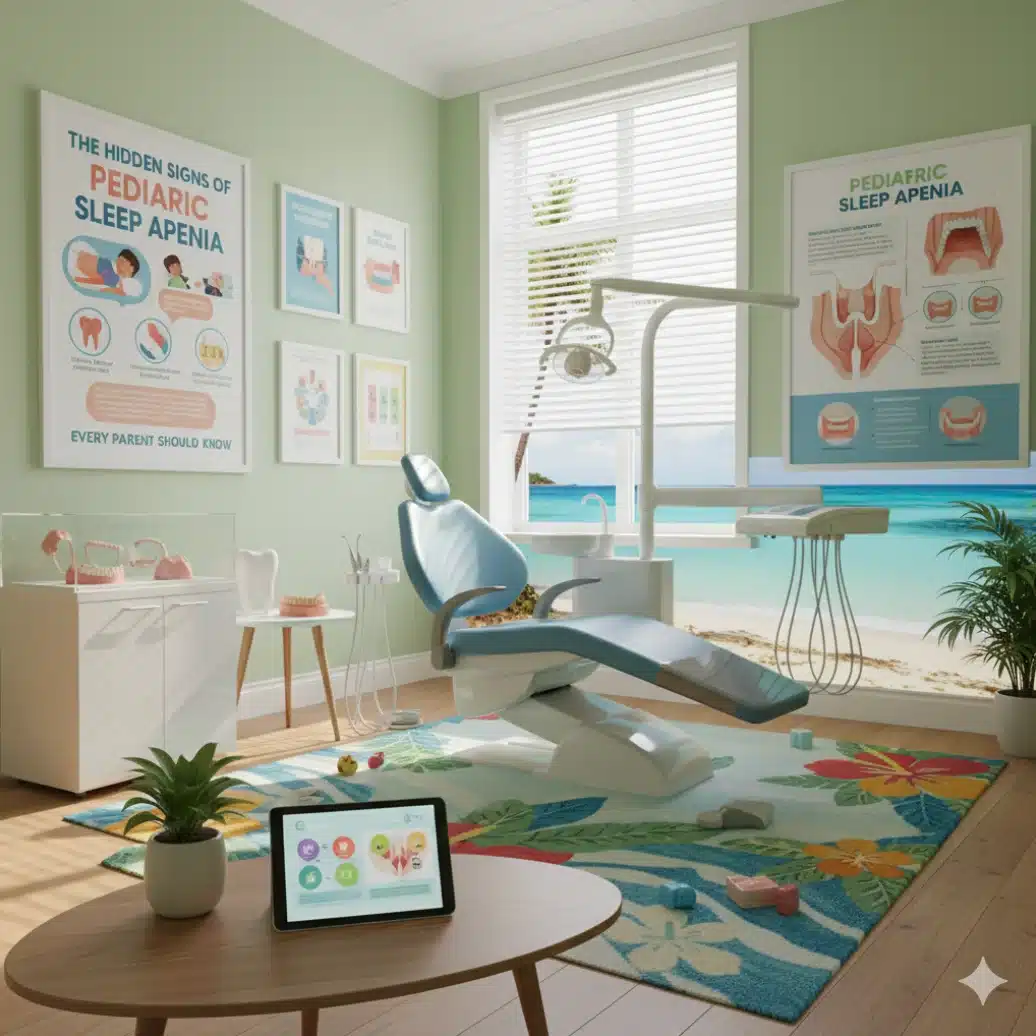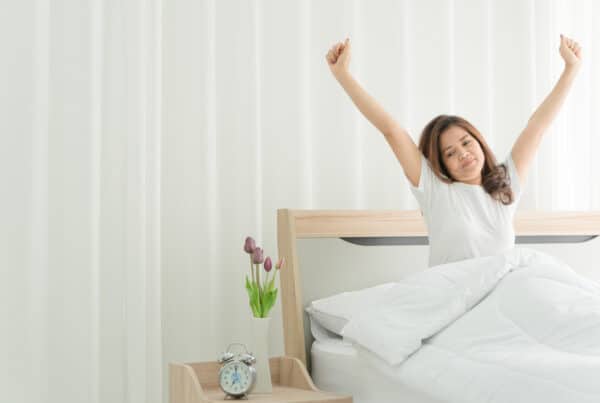A pediatric sleep study gives parents valuable answers when their child struggles with snoring, restless sleep, or daytime fatigue. This article explains what happens during a pediatric sleep study step by step so you’ll know exactly what to expect and how it helps identify sleep apnea and other breathing disorders in children across Honolulu.
Dr. Eugene Azuma of Azuma Dental has helped families across Makiki, Kakaʻako, and Manoa improve airway health and sleep through advanced dental care. With a Doctor of Dental Surgery from Georgetown University and a strong background in biology from the University of Hawaii, Dr. Azuma combines technical precision with warmth and understanding. As Vice President of the American Sleep and Breathing Academy, he continues to lead in pediatric sleep dentistry and airway-focused care for Honolulu families.
Why a Pediatric Sleep Study May Be Needed
A pediatric sleep study, also called polysomnography, measures how a child breathes and sleeps through the night. It helps diagnose sleep apnea, snoring, and other breathing issues that can affect energy levels, growth, and learning. Children who snore frequently, breathe through their mouth, or show signs of hyperactivity or poor focus may benefit from this type of test.
Dentists often recognize early symptoms during routine exams such as a narrow palate, open-mouth posture, or enlarged tonsils and refer patients for further testing. In areas like Ala Moana, Punchbowl, and Kapahulu, families are becoming more aware of how sleep studies can support their child’s long-term health.
Step-by-Step Overview of a Pediatric Sleep Study
Before the Study
Before the test, your child’s doctor or dentist will review their medical history and symptoms. Parents usually receive instructions to maintain normal bedtime routines and avoid caffeine or heavy meals. Many children find comfort in bringing a favorite blanket or stuffed animal to help them relax during the study.
Preparation steps include:
- Completing pre-sleep questionnaires
- Bringing comfortable pajamas and familiar bedtime items
- Explaining the test to your child in simple terms
This helps your child feel safe and ready for the experience. Most centers encourage parents to stay overnight to provide comfort and reassurance.
During the Study
The sleep study takes place in a child-friendly room that looks similar to a bedroom rather than a hospital. Trained technicians apply small sensors to your child’s scalp, chest, and legs to record sleep patterns, oxygen levels, breathing, and heart rate.
What happens while your child sleeps:
- Sensors measure breathing effort and oxygen changes
- Video monitoring records movement or snoring
- Staff observe in real time to ensure comfort and accuracy
The sensors are painless and designed to stay secure without causing irritation. Parents can stay nearby, making the environment calm and reassuring.
Comparing Pediatric and Adult Sleep Studies
| Type of Sleep Study | Environment | Key Measurements | Main Difference |
| Pediatric Sleep Study | Child-friendly room with parent present | Brain waves, oxygen, breathing, and movement | Focuses on growth, development, and comfort |
| Adult Sleep Study | Standard sleep lab setting | Oxygen, airflow, heart rate, and limb movement | Focuses on lifestyle and cardiovascular risk |
| Home Sleep Test | Done in your own bed | Oxygen and breathing patterns only | Simpler, less detailed than full lab testing |
Understanding these differences helps parents see why in-lab pediatric sleep studies provide the most accurate and reassuring results for children.

After the Sleep Study
When the study ends in the morning, technicians remove all sensors, and the results are reviewed by a sleep specialist. The data reveals how often breathing was interrupted, how long the child spent in deep sleep, and whether oxygen levels dropped overnight.
Dentists like Dr. Eugene Azuma collaborate closely with pediatricians and sleep specialists to interpret results and design care plans that improve airway development. Recommendations may include orthodontic treatments, nasal therapies, or myofunctional exercises to encourage healthy breathing habits.
Benefits of Pediatric Sleep Studies
Parents often feel relieved after completing a sleep study because they finally understand what’s affecting their child’s sleep. With this information, healthcare providers can create a plan that improves both nighttime rest and daytime focus. Children who get proper treatment often show noticeable improvement in school performance and behavior.
Families in neighborhoods such as Waikiki, Moiliili, and Ward Village appreciate how early testing can prevent future complications and support healthy growth. Sleep studies not only diagnose conditions but also provide peace of mind for concerned parents.
Taking the Next Step Toward Better Sleep
Good sleep leads to better learning, stronger immunity, and happier mornings. If your child snores or struggles to stay alert during the day, it might be time to schedule a pediatric sleep consultation. At Azuma Dental, Dr. Eugene Azuma and his caring team provide airway-focused evaluations, guide families through every step of the testing process, and partner with trusted specialists to deliver effective treatment options.
At Azuma Dental, you are not just booking an appointment, you are beginning a journey toward healthier breathing and brighter days for your child. Start today by scheduling an evaluation and let Dr. Azuma guide your family toward lasting wellness and restful nights.
Azuma Dental
Dr. Eugene Azuma
1580 Makaloa Street #950
Honolulu, HI 96814
(808) 955-6677
Frequently Asked Questions
What happens during a pediatric sleep study?
Knowing what to expect helps families prepare, reduces anxiety, and makes the experience easier for both children and parents.
What people should be asking instead: What is measured and how do these results help diagnose sleep disorders?
- During an overnight sleep study (polysomnogram), a sleep technician gently applies electrodes and soft sensors to your child’s scalp, face, chest, legs, and finger to measure brain waves, breathing, oxygen levels, heart rate, muscle activity, and eye movements.
- Belts around the chest and abdomen monitor breathing effort, and small tubes near the nose track airflow and carbon dioxide. A microphone and camera may record sounds/movements for more details.
- These recordings help specialists detect sleep apnea, breathing disturbances, seizure activity, and abnormal movement patterns.
Prepare for Your Child’s Sleep Study (Children’s Hospital of Philadelphia)
Is a sleep study uncomfortable for children?
Comfort and cooperation are critical for accurate test results, and for building trust with young patients.
What people should be asking instead: What do children feel and how do sleep techs keep them comfortable?
- Pediatric sleep studies are painless. Electrodes and sensors are attached with stickers or soft wraps, no needles or invasive equipment are used.
- Most children adapt well, especially with parental reassurance and familiar bedtime routines; sleep technologists are trained to keep the experience calm and friendly.
- Parents typically stay in the room overnight, and comfort items from home are encouraged.
What to Expect: Child | Upstate Sleep Center
How long does it take to get results?
Parents and kids want to move forward with answers, knowing the timeline sets expectations for next steps and follow-up appointments.
What people should be asking instead: When can my family expect a diagnosis and treatment plan after a sleep study?
- After the study, results are reviewed by a board-certified sleep medicine specialist, analysis usually takes 7 to 14 days.
- The specialist or your referring doctor will explain the results and discuss treatment options at the follow-up appointment.
- For urgent findings (like severe apnea), families may be contacted sooner; some centers offer electronic patient portals for rapid access.



